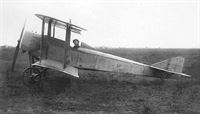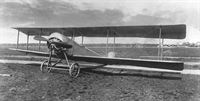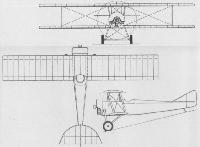М.Маслов Русские самолеты Первой Мировой (Эксмо)
«Лебедь-X»
По времени изготовления, схеме, размерам и неопределенности предназначения «Лебедь-X» близок к самолету «Лебедь-VII». Отличием явились элементы конструкции (крыло, шасси), выполненные по типу немецких «Альбатросов». «Лебедь-Х» построили в двух экземплярах - небольшой компактный биплан и биплан с увеличенным размахом крыла. Оба аппарата одноместные, снабжены двигателем «Гном» 80 л.с. Предполагались к использованию как ближний и дальний разведчики. К сожалению, малая мощность двигателя не позволила «увидеть» в этом вполне оригинальном самолете прообраз столь необходимого в ближайшем будущем истребителя.
Летные и технические характеристики «Лебедь-X» с малыми крыльями и двигателем «Рон» 80 л.с.
Размах верхнего крыла (м) 10,5
Длина в линии полета (м) 7,0
Площадь крыльев (мг) 29,0
Вес пустого (кг) 415
Скорость у земли (км/ч) 135
Показать полностью
В.Шавров История конструкций самолетов в СССР до 1938 г.
"Лебедь-Х" ("Лебедь" № 10) был выпущен в начале 1916 г. в двух вариантах. Двигатель - "Рон" в 80 л. с. Вооружение - один пулемет. Самолет имел два комплекта крыльев - большие и малые. В обоих случаях он одноместный. С малыми крыльями - это одностоечный биплан, с большими - двухстоечный. Элероны в обоих случаях - только на верхнем крыле. Фюзеляж - чистой формы с округленными верхней и нижней поверхностями, расчалочный, обтяжка - полотно.
Вариант с малыми крыльями мог бы быть истребителем, но мощность двигателя была недостаточной. С большими крыльями он как истребитель был непригоден, а как разведчик тоже маломощен. В серии не строился.
Самолет|| с малыми крыльями
Год выпуска||1916
Количество двигателей||1
Двигатель, марка||
Мощность||80
Длина самолета, м||7,0
Размах крыла, м||10,5
Площадь крыла, м2||29
Масса пустого, кг||415
Скорость максимальная у земли, км/ч||135
Показать полностью
W.Green, G.Swanborough The Complete Book of Fighters
LEBED’ X Russia
In 1916, the Aktionernoe Obitsestvo Vozdukhoplavaniya V A Lebedev, a company established in St Petersburg in 1912 by Vladimir A Lebedev and Prof A A Lebedev, developed an equi-span biplane of original design as the Lebed’ X. Owing much to experience gained with the Lebed' VII, an unarmed copy of the Sopwith Tabloid, the Lebed’ X was built in two versions: a single-bay biplane intended as a single-seat fighter and a two-bay biplane intended for the reconnaissance role. Both were powered by the 80 hp Le Rhone rotary and were armed with a single synchronised machine gun, but proved underpowered. Neither fighter nor reconnaissance model progressed further than prototype test.
Max speed, 84 mph (135 km/h).
Empty weight, 915 lb (415 kg).
Span, 34 ft 5 1/3 in (10,50 m).
Length, 22 ft 11 1/2 in (7,00 m).
Wing area, 312.16 sq ft (29,00 m2).
Показать полностью
H.Nowarra, G.Duval Russian Civil and Military Aircraft 1884-1969
Two other experimental scouts were completed in early 1916, both designed by V. A. Lebedev and built in Petrograd. The Lebed VII had an 80 h.p. Gnome engine, but its performance did not approach that of Sikorski’s fighter, and the second machine, the Lebed X, appears to have had no special virtues either. Contemporary reports indicate that both of these designs were based on that of German Albatros aircraft which Lebedev had built before the war.
Показать полностью
A.Durkota, T.Darcey, V.Kulikov The Imperial Russian Air Service (Flying Machines)
Lebed 9
The Lebed 9 was an experimental single-seat scout powered by an 80hp Gnome or Le Rhone rotary engine. A single-bay biplane, it employed ailerons on the upper wing. All struts were wood and the fuselage was fabric covered with the top and bottom being rounded. The forward deck around the cockpit was wooden and featured a headrest for the pilot. The cowl panels were gray metal. Performance was stated as being unsatisfactory and only the prototype was built.
Lebed 10
The Lebed 10 was a two-seat experimental biplane with a long, two-bay wing. It incorporated ailerons on both upper and lower wings and the actuating cable was externally mounted, traveling through pulleys installed at the leading edge of the wings which are clearly visible in photographs. Wing struts were of wood while landing gear and cabane supports were of steel tube, a standard construction method on most Lebeds. Similar in style to the Lebed 9, the fuselage maintained the fabric covering and the round shape of the top and bottom areas. This model did away with the headrest and featured only a half cowl exposing most of its 80hp Le Rhone engine. The forward metal surfaces featured large access panels for servicing, similar to the Nieuport style. It was underpowered and not suitable for reconnaissance work; consequently only a few were built.
Показать полностью







